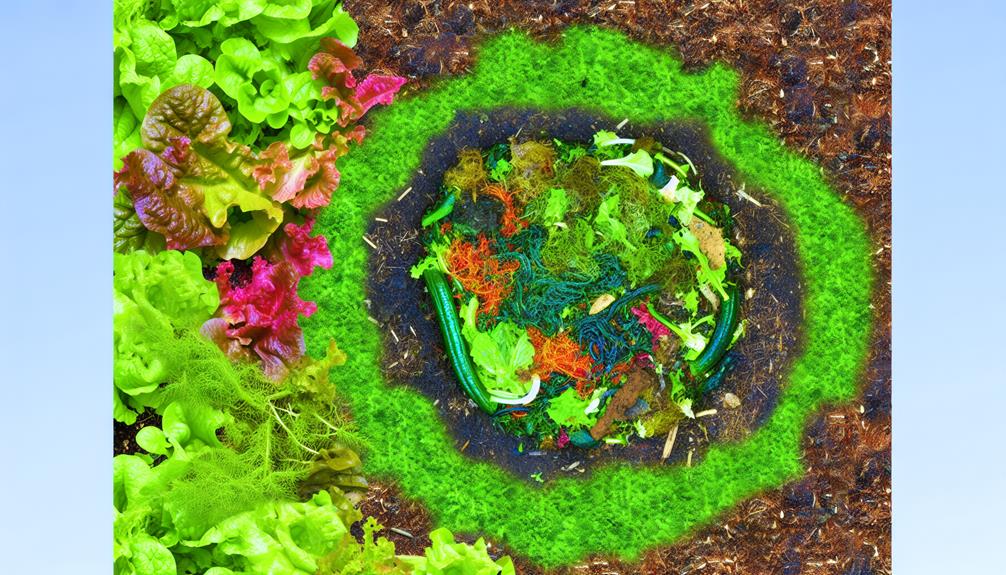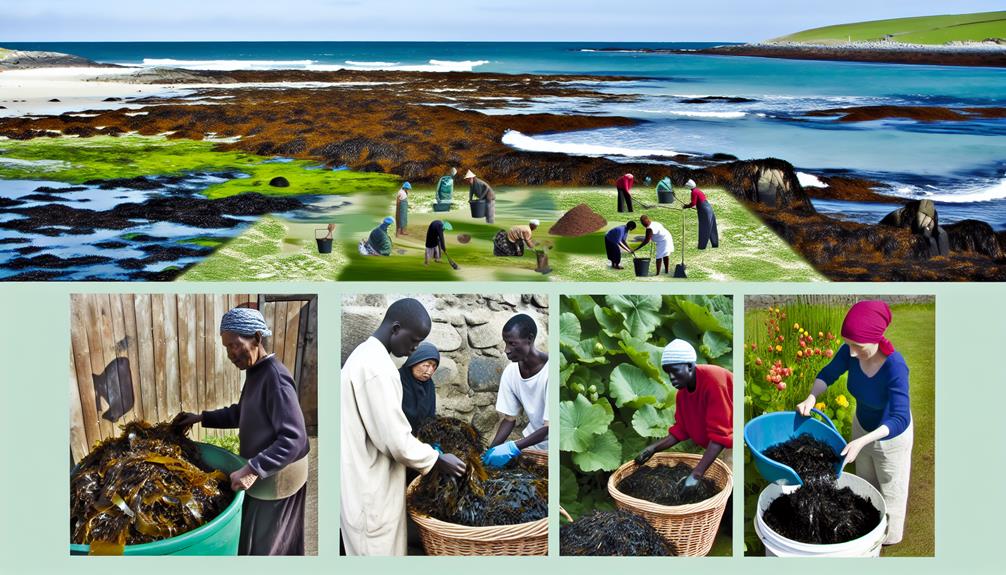

Yes, you can compost seaweed. It’s rich in essential nutrients like nitrogen, potassium, and phosphorus, which boost soil health. Start by rinsing off the salt and chopping it into small pieces to speed up decomposition. Mix seaweed with green materials like grass clippings in a 1:2 ratio for balance.
Guarantee your compost pile remains moist but not soggy, and turn it regularly to introduce oxygen. Avoid overcrowding to maintain proper airflow. Composting seaweed can enhance soil structure, moisture retention, and microbial activity, leading to healthier plants. For more tips and detailed steps, you’ll find a lot of useful information ahead.\
Composting seaweed offers multiple environmental and agricultural benefits. By incorporating seaweed into your compost, you’re taking a significant step towards sustainable gardening. Seaweed is rich in essential nutrients like nitrogen, potassium, and phosphorus, which are vital for plant growth. When you compost seaweed, these nutrients become available to your plants in a natural and organic form, which is a cornerstone of organic farming.
In addition to its nutrient profile, seaweed helps improve soil structure. It acts as a natural soil conditioner, enhancing moisture retention and aeration. This means healthier roots and more robust plants for your garden. It’s particularly beneficial if you’re working with sandy or clay-heavy soils that need better texture and drainage.
Another great aspect is its ability to introduce beneficial microorganisms into the soil. These microorganisms aid in breaking down organic matter, making nutrients more accessible to plants. This aligns perfectly with the principles of sustainable gardening and organic farming, where the focus is on creating a self-sustaining ecosystem.
To start, simply collect seaweed, rinse off excess salt, and mix it into your compost pile. You’ll see the positive impacts on your garden’s health and productivity.
Also Read: Can You Compost Canned Fruits?
When choosing seaweed for your compost, focus on varieties like kelp, rockweed, and bladderwrack for their rich nutrient profiles. These types of seaweed are well-known for their high mineral content, making them excellent additions to your compost pile.
To start, you’ll need to identify these types accurately. Kelp is usually large and brown, with long, ribbon-like fronds. Rockweed, on the other hand, appears as smaller, bushy clumps, often found on rocky shorelines. Bladderwrack can be identified by its distinct air-filled bladders that help it float.
Seasonal availability is also important. Seaweed is often more abundant after storms or during certain times of the year. Collecting it after a high tide or storm can yield a good haul. Just be sure to gather responsibly, leaving some behind to guarantee the ecosystem remains healthy.
You’re part of a community that values sustainable gardening practices, and using seaweed in your compost is a step in the right direction. By selecting the right types and knowing when to collect them, you’ll enhance your compost’s quality and contribute to a more sustainable environment.
Also Read: Can You Compost Candy Wrapper?
When composting seaweed, you’ll find it’s packed with essential minerals that enrich your soil.

These natural growth stimulants boost plant health and productivity.
Incorporating seaweed into your compost can greatly enhance soil quality, making it a valuable addition to your gardening practices.
Loaded with essential nutrients, seaweed is a powerhouse of minerals that can greatly enhance your compost. When you add seaweed to your compost pile, you’re introducing a rich mineral content that includes iodine, calcium, magnesium, potassium, and an array of trace elements. These minerals are vital for soil enrichment, helping to create a fertile environment for your plants to thrive.
To maximize the benefits, chop the seaweed into smaller pieces before adding it to your compost. This speeds up the decomposition process and guarantees an even distribution of nutrients. Don’t worry about rinsing off the seaweed; a bit of salt can actually be beneficial, adding extra minerals to your compost.
Incorporate seaweed into your compost just like any other green material. Balance it with brown materials, such as leaves or straw, to maintain the right carbon-to-nitrogen ratio. This balance is important for effective composting.
Seaweed contains natural growth stimulants that can greatly enhance plant development and yield. When you use seaweed in your compost, you’re introducing essential plant hormones and growth enhancers that can make a significant difference in your garden. These natural substances help plants grow faster, stronger, and healthier.
Here are some key benefits of the growth stimulants found in seaweed:
The nutrients in seaweed greatly enhance soil health by boosting its fertility and structure. When you add seaweed to your compost, you’re introducing a rich source of essential minerals like potassium, nitrogen, and magnesium. These minerals are important for plant growth and help improve the overall nutrient content of your soil.
Seaweed also contains trace elements that support enzymes and hormones important to plant health. As seaweed breaks down in your compost, it releases these nutrients slowly, providing a steady supply over time. This gradual nutrient release is beneficial because it guarantees that your plants can absorb what they need without the risk of nutrient burn.
Moreover, seaweed significantly improves soil structure. The organic matter from seaweed enhances the soil’s ability to retain moisture and improves aeration, which is crucial for root development. It also boosts microbial activity, fostering a healthy ecosystem of beneficial bacteria and fungi in your soil. These microbes break down organic matter more efficiently, making nutrients more available to plants.
Incorporating seaweed into your compost can transform your soil into a richer, more fertile medium. You’ll be fostering a thriving environment for your plants and contributing to a more sustainable gardening practice.
Also Read: Can You Compost Candy?
When gathering seaweed, always make sure you’re doing so in a way that doesn’t harm the local ecosystem. Start by checking local regulations, as these can guide you on what’s permissible. Some areas have restrictions to protect marine life and habitats, so it’s important to respect these rules to minimize your environmental impact.
To make sure you’re collecting seaweed responsibly, follow these guidelines:
To prepare seaweed for composting, start by rinsing off any salt to avoid harming your plants.

Next, chop it into small pieces to speed up decomposition.
Before adding seaweed to your compost, make sure you thoroughly rinse off the salt. Seaweed naturally accumulates salt from the ocean, which can harm your compost and garden soil if not properly removed. To achieve effective salt removal, follow these steps to make sure your seaweed is ready for composting.
First, gather your seaweed and rinse it in fresh water. This initial seaweed rinsing helps to wash away the bulk of the salt. Here’s a simple approach:
By rinsing the seaweed multiple times, you make certain that most of the salt is removed, making it safe for composting. This step is important because too much salt can disrupt the microbial activity necessary for effective composting. Additionally, excess salt can lead to soil salinity issues, which may hinder plant growth.
Rinsing your seaweed properly will help you create nutrient-rich compost that benefits your garden. Remember, taking the time for thorough salt removal now will pay off with healthier, more productive soil later.
Cutting the seaweed into smaller pieces speeds up the decomposition process, guaranteeing it breaks down more efficiently in your compost. To get started, you’ll need the proper tools and some basic cutting techniques. A sturdy pair of garden shears or a sharp knife works best for this task. Make sure your tools are clean to prevent any potential contamination.
First, lay the seaweed on a flat surface like a cutting board or a clean piece of tarp. Hold the seaweed firmly and cut it into manageable pieces, aiming for lengths of about 2 to 3 inches. This size is ideal because it allows for better air circulation and quicker breakdown in your compost pile.
When you’re cutting, try to maintain uniformity in the pieces. Consistent sizes ensure that the seaweed decomposes evenly. If you have a large amount of seaweed, consider using a mulching machine for efficiency.
Once you’ve chopped the seaweed into smaller pieces, it’s time to mix it with green materials to balance your compost. Various seaweed types, such as kelp, bladderwrack, and nori, are excellent additions to your compost mixture due to their high nutrient content.
To create a well-balanced compost, you’ll need to combine the seaweed with green materials (nitrogen-rich) and brown materials (carbon-rich).
Here’s what you can add to your compost along with seaweed:
For best results, aim for a compost mixture ratio of one part seaweed to two parts green materials. This balance ensures that your compost pile heats up properly and decomposes efficiently.
When mixing, layer the seaweed and green materials, ensuring they’re evenly distributed throughout the pile. Turn the compost regularly to maintain aeration and speed up the decomposition process.
With the right mixture, you’ll create rich, nutritious compost that benefits your garden soil immensely.
Also Read: Can You Compost Candle Wax?
To achieve an effective compost mixture, it’s important to balance green and brown materials properly. Green materials, like vegetable scraps, grass clippings, and coffee grounds, provide nitrogen and help heat up the compost pile. Brown materials, such as dried leaves, cardboard, and straw, supply carbon, which keeps the pile aerated and prevents it from becoming too wet.
You want a balanced ratio of about two-thirds brown to one-third green materials. This guarantees the compost decomposes efficiently and avoids unpleasant odors. Start by layering brown materials at the bottom of your compost bin, creating a base that allows air to circulate.
Next, add a layer of green materials, followed by another layer of brown. Keep alternating layers to maintain balance.
Turning the pile regularly is important because it mixes the materials and introduces oxygen, speeding up decomposition. If the pile is too wet and smelly, add more brown materials. Conversely, if it’s too dry and slow to break down, mix in more green materials.
With this balance, your compost will thrive, creating nutrient-rich soil for your garden. Remember, the right mix of green and brown materials is key to successful composting.
When you add seaweed to your compost, you’re giving it a nutrient-rich boost that enhances soil health.
Seaweed helps balance the carbon and nitrogen ratio, making your compost more efficient.
Just combine it well with other materials to guarantee even decomposition.
Seaweed adds a powerhouse of nutrients to your compost, enhancing its ability to nourish plants. By incorporating seaweed into your compost, you’re ensuring a rich mix of essential minerals and trace elements. Seaweed is a natural source of potassium, nitrogen, and magnesium, which are crucial for healthy plant growth.
Adding seaweed to your compost can help debunk some common composting myths. Contrary to some beliefs, seaweed doesn’t disrupt the composting process or introduce harmful elements. In fact, it’s an excellent addition, comparable to other seaweed alternatives.
Here’s what you can expect from using seaweed in your compost:
Don’t let myths steer you away from using seaweed. Embrace it as a valuable addition to your composting routine. By doing so, you’re not only improving your compost but also fostering a sense of community with others who value sustainable and effective gardening practices.
Balancing carbon and nitrogen in your compost is crucial for efficient decomposition and high-quality compost. To achieve this balance, you need to manage the carbon ratio and nitrogen sources properly.
Seaweed is an excellent addition because it’s rich in nitrogen, which helps break down the carbon-heavy materials in your pile. When you add seaweed, you’re introducing a valuable nitrogen source. However, you’ll also need to balance it with carbon-rich materials such as dry leaves, straw, or cardboard.
Aim for a carbon ratio of about 30:1, which means for every part of nitrogen, you’ll want thirty parts carbon. This ratio creates the ideal environment for microbes to thrive and break down the materials efficiently.
To incorporate seaweed effectively, mix it thoroughly with your existing compost materials. Don’t add too much seaweed at once, as it can create an imbalance. Instead, layer it with other compostable items.
Keep your pile moist but not soggy, and turn it regularly to guarantee even decomposition.
To expedite seaweed decomposition, you need to guarantee it receives the right balance of moisture, aeration, and nutrients. Ensuring these factors will invigorate microbial activity, which is essential for breaking down seaweed efficiently.
One effective strategy is to use decomposition accelerators, which can greatly speed up the process.
Here are three ways to make sure your seaweed compost is breaking down quickly:
Also Read: Can You Compost Cake?
One common mistake is neglecting to rinse the seaweed before composting, which can lead to excess salt content that hinders microbial activity. Salt can be detrimental to the beneficial organisms that break down compost materials. Always give seaweed a good rinse to guarantee a healthy compost environment.

Another frequent error is overcrowding bins. When you add too much seaweed to your compost bin at once, it can create an imbalance. Composting thrives on a balanced mix of green (nitrogen-rich) and brown (carbon-rich) materials. Too much seaweed, a green material, can throw off this balance, slowing decomposition.
Improper layering is also a pitfall. Layer your compost materials properly to promote airflow and efficient breakdown. Start with a layer of coarse brown materials like twigs or straw at the bottom. Follow this with alternating layers of green and brown materials.
When adding seaweed, be sure to mix it with other compostable materials. This helps maintain the right moisture level and prevents compaction, which can lead to anaerobic conditions.
Also Read: Can You Compost Cadaver?
After successfully composting seaweed, you can harness its nutrient-rich benefits to enrich your garden soil and boost plant growth. Seaweed-enriched compost acts as an excellent soil conditioner, providing a wealth of trace minerals and nutrients essential for healthy plant development.
Here’s how you can make the most of it:
When you incorporate seaweed-enriched compost into your gardening routine, you’re not just feeding your plants; you’re also fostering a sense of community with nature and other gardeners who share your passion. By using seaweed mulch and marine fertilizers, you contribute to a sustainable gardening practice that benefits both your garden and the environment.
With these steps, your garden will thrive, and you’ll feel connected to a broader eco-friendly community.
Yes, seaweed can attract pests to your compost pile, but using pest deterrents and compost covers can help. You’re part of a community that values eco-friendly solutions, so take these steps to protect your compost.
Yes, there’s a smell when composting seaweed, but it’s manageable. The decomposition rate is quick, which helps with odor control. Mixing it with other compost materials and turning the pile regularly will make you feel at home.
You should add seaweed to your compost in small amounts, mixing it well each time. This guarantees proper nutrient distribution and helps with compost aeration. By doing this, you’ll create a thriving compost community.
You can compost seaweed any season, but keep in mind its seasonal availability. Winter challenges like freezing temperatures might slow down decomposition. Join your community’s compost group to share tips and make the process smoother for everyone.
Yes, seaweed can affect the pH level of your compost. It contributes to soil enrichment due to its high mineral content, helping balance the pH and creating a welcoming environment for plants and fellow gardeners.
To sum up, composting seaweed is a beneficial and straightforward process. Make sure you collect seaweed responsibly, avoid adding too much at once, and mix it well with other compost materials.
Its rich nutrients will enhance your compost, speeding up decomposition and improving soil health. Follow these steps, and you’ll have nutrient-rich compost ready for your garden.
Remember, balance is key, so diversify your compost ingredients for the best results. Happy composting!
